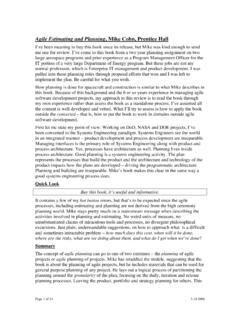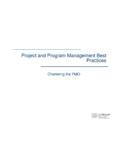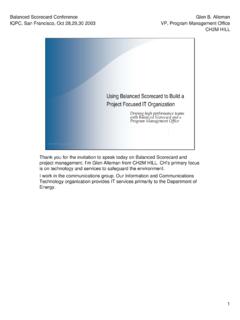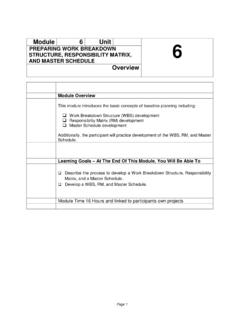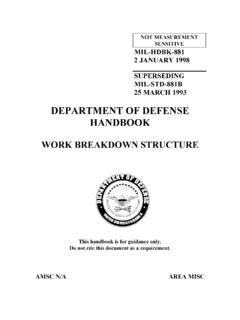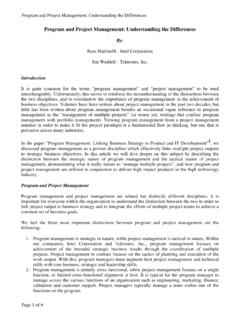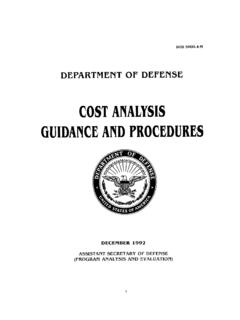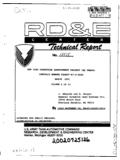Transcription of An Introduction to IMP/IMS - Niwot Ridge
1 IMP/IMS 2003 the US Government revised its acquisition policies with a procurement strategy focused on process improvement and acquisition reform implemented by performance-based Introduction to IMP/IMSGlen B AllemanNiwot, ColoradoPlanning projects usually starts with tasks and milestones. The planner gathers this information from the participants customers, engineers, subject matter experts. This information is usually arranged in the form of activities and milestones. PMBOK defines project time management in this manner.
2 The activities are then sequenced according to the projects needs and mandatory usual critical path methods are then used to determine the estimated completion date, risk areas of the project and other statistical planning s missing from the concept of this task-oriented schedule is the realization that the plan is not the same as done. A description of done is usually not part of the plan in an explicit manner. Rather is usually found inside of a specification. It s there in implicit form after all the tasks are the US Department of Defense version of PMBOK Section 6 (Project Time Management) this task-oriented approach is replaced by IMP/IMS .
3 Why was this done? The DoD version as well as the US Air Force IMP/IMS guides don t explicitly state the reason for replacing the traditional planning approach with 2/54 Program Management is a Full Contact SportWe ve all had experiences in much the same as the carton charters shown here. Things are going along well, even the numbers all look good. Then the surprise happens. Sometimes out of the blue, sometimes with a clear vision of the train wreck happening before our does the happen? If there was a simple answer to this question all the efforts of program management, tools and processes would not be needed.
4 The answer is we don t really know why projects fail in any detail that would allow us to avoid failure with certainty. There are many authors, professional organizations, and government agencies who profess to have a solution. But in the end its simply not possible to state assuredly how to avoid for improvement certainly exist. Obvious failure modes can be identified and avoided. Postmortems can easily identify the gaps that occurred with or without the knowledge of the project managers, customers, and 3/54 Booz Allen Hamilton s 16 Program Management Processes Program EnablersProgram Process CapabilitiesBusiness Enablers15: PM Process Management15: PM Process Management16: PM development and Succession16: PM development and SuccessionProgram Management Framework11: Organization/IPD11: Organization/IPD12: Customer Partnership12: Customer Partnership13: Program Review Process13.
5 Program Review Process14: Configuration/ Data Management14: Configuration/ Data Management2: Program Planning2: Program Planning3: Performance Management3: Performance Management4: Sub-Contract Management4: Sub-Contract Management5: Follow-On Business Development5: Follow-On Business Development9: Financial Management9: Financial Management10: Risk Management10: Risk Management7: Requirements Management7: Requirements Management8: Schedule Management8: Schedule Management6: Earned Value Management6: Earned Value Management1: Program Management Involvement in Proposal 1: Program Management Involvement in Proposal Booz Allen Hamilton defined 16 processes for program management.
6 These all appear obvious on the surface as any good idea challenge is to put these practices into practice on real programs with real people and real Program Process Capabilities (1 10) are the core of the IMP/IMS outcomes. Planning, performance management, subcontract relations, cost, and earned value are critical operational activities for the success of any these processes to be effective, there has to be a clearly defined statement of work, a cooperative customer, a skilled and qualified team, proper funding, and most importantly a feasible solution to the customer s even with all these pre-conditions, projects get in s missing?
7 The IMP/IMS approach would say what s missing is a way to assess the incremental progress of the program in a way that can be measured in unambiguous terms. By defining done in terms of events, accomplishments, and criteria, progress of the program can be 4/54 Why IMP/IMS ?zProposal Preparation Emphasize real integrated product development Provide flexibility in performing detailed planningzContract Award At post-award conference, provides a basis of mutual understandingzProgram Execution Identify and assess program progress based on done rather then passage of time or effort expended Assess program maturity through pre-defined accomplishmentsThere are no simple answers for the question why use IMP/IMS ?
8 As well there doesn t seem to be much in the way of documentation for the deployment of IMP/IMS . The fact is though that the world is littered with failed projects. Even after decades of professional development , bodies of knowledge, endless seminars and training processes and even Presidential are an equal number of successful projects. The parametersof project success or project failure are elusive. But one thing is clear, without a concise definition of done , no process will 5/54 What is the Integrated Master Plan?
9 ZThe IMP is an event based plan, rather than a task basedplan A hierarchy of program events defines the program flow Each event is supported by specific accomplishments Each accomplishment has specific criteria to be satisfiedzThe IMP tracks the step-by-step completion of the required accomplishments for each eventzThe IMP demonstrates the satisfactory completion criteria for each accomplishmentThe Integrated Master Plan is a collection of milestones ( IMP/IMS calls them events) that form the process architecture of the program.
10 This means the sequence of events that will result in a deliverable product or products or services is relatively straight forward in many cases. List the tasks to be done, arrange them in the proper sequence, execute this plan. Several problems appear immediately: The description of done is many times missing for the intermediate activities. As products or services are delivered the maturity of the program is as critical as quality, functionality, and other program attributes. This maturity is an insurance policy against problems encountered in the program.


